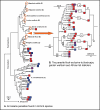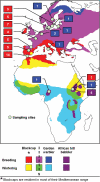Within-host speciation of malaria parasites
- PMID: 17311104
- PMCID: PMC1794596
- DOI: 10.1371/journal.pone.0000235
Within-host speciation of malaria parasites
Abstract
Background: Sympatric speciation-the divergence of populations into new species in absence of geographic barriers to hybridization-is the most debated mode of diversification of life forms. Parasitic organisms are prominent models for sympatric speciation, because they may colonise new hosts within the same geographic area and diverge through host specialization. However, it has been argued that this mode of parasite divergence is not strict sympatric speciation, because host shifts likely cause the sudden effective isolation of parasites, particularly if these are transmitted by vectors and therefore cannot select their hosts. Strict sympatric speciation would involve parasite lineages diverging within a single host species, without any population subdivision.
Methodology/principal findings: Here we report a case of extraordinary divergence of sympatric, ecologically distinct, and reproductively isolated malaria parasites within a single avian host species, which apparently occurred without historical or extant subdivision of parasite or host populations.
Conclusions/significance: This discovery of within-host speciation changes our current view on the diversification potential of malaria parasites, because neither geographic isolation of host populations nor colonization of new host species are any longer necessary conditions to the formation of new parasite species.
Conflict of interest statement
Figures




Similar articles
-
Prevalence and beta diversity in avian malaria communities: host species is a better predictor than geography.J Anim Ecol. 2014 Nov;83(6):1387-97. doi: 10.1111/1365-2656.12246. Epub 2014 Jun 16. J Anim Ecol. 2014. PMID: 24810878
-
Host specialization and geographic localization of avian malaria parasites: a regional analysis in the Lesser Antilles.Am Nat. 2005 Apr;165(4):466-80. doi: 10.1086/428430. Epub 2005 Feb 18. Am Nat. 2005. PMID: 15791538
-
Avian haematozoan parasites and their associations with mosquitoes across Southwest Pacific Islands.Mol Ecol. 2008 Oct;17(20):4545-55. doi: 10.1111/j.1365-294X.2008.03935.x. Mol Ecol. 2008. PMID: 18986499
-
Species limits in avian malaria parasites (Haemosporida): how to move forward in the molecular era.Parasitology. 2014 Sep;141(10):1223-32. doi: 10.1017/S0031182014000560. Epub 2014 May 9. Parasitology. 2014. PMID: 24813385 Review.
-
How can we determine the molecular clock of malaria parasites?Trends Parasitol. 2013 Aug;29(8):363-9. doi: 10.1016/j.pt.2013.03.011. Epub 2013 May 3. Trends Parasitol. 2013. PMID: 23648374 Review.
Cited by
-
Patterns in avian malaria at founder and source populations of an endemic New Zealand passerine.Parasitol Res. 2012 Nov;111(5):2077-89. doi: 10.1007/s00436-012-3055-y. Epub 2012 Aug 9. Parasitol Res. 2012. PMID: 22875394
-
Genetic characterization, distribution and prevalence of avian pox and avian malaria in the Berthelot's pipit (Anthus berthelotii) in Macaronesia.Parasitol Res. 2008 Nov;103(6):1435-43. doi: 10.1007/s00436-008-1153-7. Epub 2008 Sep 2. Parasitol Res. 2008. PMID: 18762985
-
Haemosporidian parasites of a European passerine wintering in South Asia: diversity, mixed infections and effect on host condition.Parasitol Res. 2013 Apr;112(4):1667-77. doi: 10.1007/s00436-013-3323-5. Epub 2013 Feb 6. Parasitol Res. 2013. PMID: 23385972
-
Molecular characterization and morphological description of cryptic haemoproteids in the laughingthrushes (Leiothrichidae) in the western and eastern Himalaya, India.Wellcome Open Res. 2018 Aug 1;3:94. doi: 10.12688/wellcomeopenres.14675.1. eCollection 2018. Wellcome Open Res. 2018. PMID: 30450425 Free PMC article.
-
A comparison of multiple methods for estimating parasitemia of hemogregarine hemoparasites (apicomplexa: adeleorina) and its application for studying infection in natural populations.PLoS One. 2014 Apr 17;9(4):e95010. doi: 10.1371/journal.pone.0095010. eCollection 2014. PLoS One. 2014. PMID: 24743340 Free PMC article.
References
-
- Kreier JP. Parasitic protozoa. 2nd edition. New York: Academic Press; 1994.
-
- Pérez-Tris J, Hasselquist D, Hellgren O, Krizanauskiene A, Waldenström J, Bensch S. What are malaria parasites? Trends Parasitol. 2005;21:209–211. - PubMed
-
- Bensch S, Pérez-Tris J, Waldenström J, Hellgren O. Linkage between nuclear and mitochondrial DNA sequences in avian malaria parasites – multiple cases of cryptic speciation? Evolution. 2004;58:1617–1621. - PubMed
-
- Ricklefs RE, Fallon S, Bermingham E. Evolutionary relationships, cospeciation, and host switching in avian malaria parasites. Syst Biol. 2004;53:111–119. - PubMed
-
- Waldenström J, Bensch S, Kiboi S, Hasselquist D, Ottosson U. Cross-species infection of blood parasites between resident and migratory songbirds in Africa. Mol Ecol. 2002;11:1545–1554. - PubMed
Publication types
MeSH terms
Substances
LinkOut - more resources
Full Text Sources

